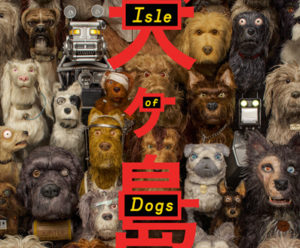 (4 / 5)
(4 / 5)
What connects Wes Anderson’s work? His style is instantly recognisable as having characters center framed and facing the camera, staging most of the shots like a play and quirky characters that talk fast. But what does he have to say as an artist? They are all so him while being so different. Isle of Dogs is unlike anything else but at the same time could only have been made by Wes Anderson.
A tale about a time in Japan where a virus has spread among dogs so all the dogs in Japan have been dumped onto a remote trash island and left there. While there, a pack has formed between Chief (Bryan Cranston), Rex (Edward Norton), King (Bob Balaban), Boss (Bill Murray) and Duke (Jeff Goldblum). This pack is a democracy, no single dog is the leader so every decision must be voted on. This leads to it being used three times and the third time is the true punchline. One day a little plane fly’s over and crashes on the island. From it, a little pilot emerges. It is a boy named Atari Kobayashi (Koyu Rankin), he is looking for his lost dog Spots, so begins this quest to find this little boy’s lost dog, that he loves so much and face obstacles and meet other characters along the way.
I don’t know how Wes Anderson continually gathers the most impressive cast anyone can possibly have in a movie. There are his usual collaborators here like Tilda Swinton, Jeff Goldblum, and Bill Murray and there are high profile actors that have never worked with before like Bryan Cranston, Greta Gerwig and Yoko Ono. Some of it is surely helped by the fact that he is a high-profile director and working with him would be a rewarding endeavor. Maybe because when he asks these actors to play these characters they would never get asked to play anything like them again so they jump at the chance?
This is one of Cranston’s best roles and performances. We have seen that he is capable of being funny, dramatic and very threatening. Chief gives him the ability to be all. He is a stern leader, a tough fighter that nobody should mess with, the comedic straight-man and tenderly emotional. Through the microphone, Cranston delivers these adjustments in the character in the most controlled way.
This is Andersons second stop-motion movie, the first one being Fantastic Mr. Fox. He enjoyed the process so much that for a while this movie was simply known as “Untitled Stop-Motion movie.” There is something about the texture and mentality of the exact medium of stop-motion that Anderson is suited for. Perhaps it is the mix of cutting down on frames so you can see the skips in the movement? Perhaps it’s how precisely envisions things that animation allows him to execute said vision to a tee? Maybe the handmade quality which makes it more organic? Whatever it is exactly this is an artist working in a medium they revel in.
Usually, with a movie about humans and animals going on a journey the humans are the ones we can understand and its the animals we interpret through behavior. Here, in a delightfully refreshing switch up it is the other way round. I do question how this will translate for the Japanese audience, part of the point is that they cant understand the language but understand them through tone and gestures. In other scenes with just humans, other things like tone and visuals help us understand the information. Will they just bite the bullet and have both dogs and humans speaking the same language? Or will they translate the humans into English or another language? Either way, it will seem odd.
Being that the movie is set in Japan this movie marks a big aesthetic shift for Anderson. His movies have been heavily western focused but now with the large location change he has immersed himself in the culture and narrowed in on the most beautiful aspects that he can also utilise into his own work. The human faces are sculpted to look Asian (and are not offensive), he embraces having kanji over most things and utilized more classic Japanese imagery like Hokusai’s The Great Wave off Kanagawa. Also, pay attention for a Seven Samurai reference.
Anderson isn’t so much interested in plotting his movies as is traditional (actually nothing about Anderson is traditional). He really delves into settings and scenarios in which he is allowed to highlight character moments and indulges in visuals. The plot doesn’t really play out, more unfold.
So what is the connection with all of this and the others of Anderson’s work? Well, I’m pretty sure he’s pro dog, he really loves people and giving his character’s quirks. They all go on journey’s of some kind of self-discovery but that’s just one of the hallmarks of storytelling. I guess he’s just a man that loves to make things and has a certain style of going about it but allows variation.

